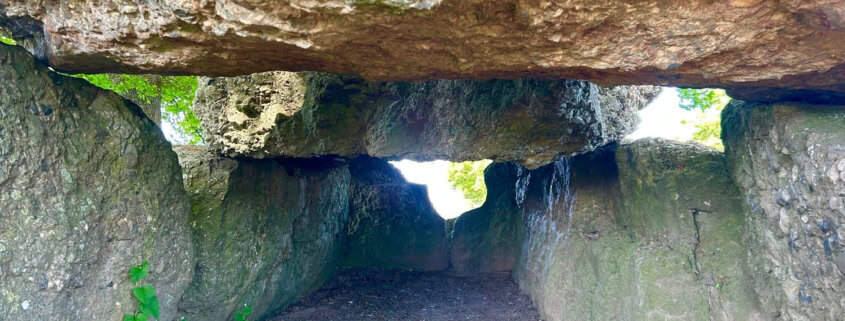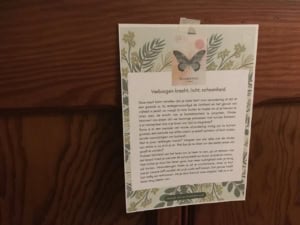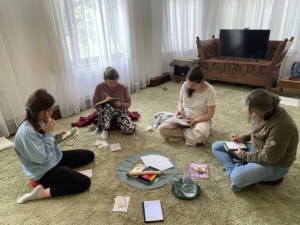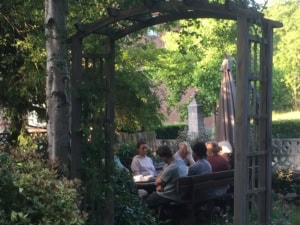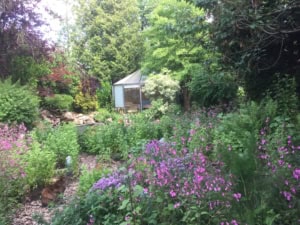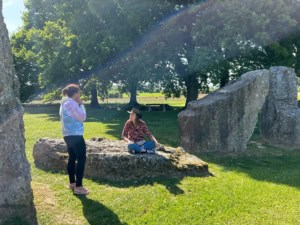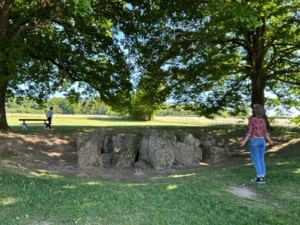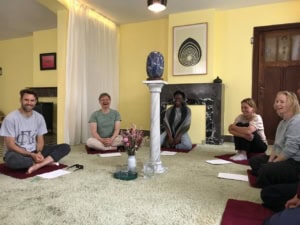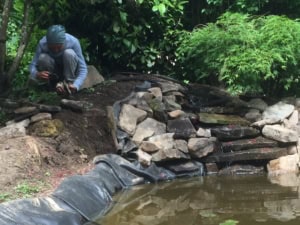Asharum Amonines in May: Mastery Through Repetition: Life, Perception, and Transformation
Ley lines
This month, the Asharum was rented out for four days as the venue for an Inner Journey Retreat. Guests were warmly welcomed, and each door had a unique text attached to it. Whether participants were free to choose a room based on the text that resonated with them—or whether the rooms had been pre-assigned—we don’t know. Either way, it felt like an intentional gesture, offering direction or reflection for the days to come.
As the retreat progressed, we saw the faces of the participants becoming more relaxed and joyful as they shared sessions, outings, and meals together.
The group size of the Inner Journey Retreat left enough room for a second group to stay at the Asharum during the same period, albeit for fewer days. Interestingly, both groups planned an outing to Wéris, a nearby village known for a more than 5-kilometre-long alignment of menhirs and dolmens, positioned along so-called Ley lines.
Ley lines are often linked with the earth’s energy lines. However, while Ley lines are always straight, earth energy lines tend to meander. These lines appear to connect natural landmarks such as trees or mountaintops with ancient sites—megaliths, wells, and signposts. It is said that Asharum in Amonines is also located on such a line or crossing of lines.
Given the many perspectives on their meaning, we’d like to follow these lines—and the stories attached to them—across the world.
In Irish folklore, for instance, spirit paths or fairy lines are traditionally straight and often marked by similar features as Ley lines, linking them possibly to ancient funerary traditions.
In Chinese culture, Ley lines resemble the principles of feng shui—literally ‘wind and water’—which identifies the flow of Lung-mei, or dragon currents. In this view, the lines map the earth’s magnetic fields to re-fertilise the land, similar to how Australian Aboriginals use songlines or dream lines.
Interestingly, horticulturalists have found that plants placed in a magnetic field grow more than six times faster than under normal conditions. This could be one possible explanation for the lush garden in Amonines—if one feels the need to explain it at all...
Beyond this, Aboriginal songlines are also used to transmit messages across vast distances. This opens up another interpretation of Ley lines—not just as energetic channels, but as forms of ancient communication.
Lastly, some believe that megalithic cultures used these lines in connection with astronomy. Larger constructions may have been designed to track celestial bodies and measure their cycles. Often, these structures align with Ley lines—or the points where several lines intersect. With astronomical positioning mirrored in geometric layouts, some sites appear to exhibit an 'accidental' or perhaps intuitive geometry.
The wisdom of repetition
Living at Asharum Amonines, daily life—with all its tasks—often becomes an act of repetition. The true variety lies in how we value the process. The approach to creating a meal or pruning a tree may differ each time, as do the ingredients or the tree itself. The attitude with which you approach what needs to be done, attuned in Asha (1), can also shift, profoundly shaping the experience.
But repetition should not be avoided, for it reinforces a sense of certainty and can lead to mastery—not in the sense of acquiring a skill, but in truly understanding what you are seeking to master. This understanding comes from within; one must become that which one wishes to master.
Following this line of thought, if we consider how our attitudes colour our experiences, one could say that in order to steer your life in the desired direction—a direction that in its broadest sense leads to a life of Well-Being—you must become that direction. In Nâm living, this means managing your own Habitual Programms of Perception (2).
Mastering your own life
At the end of May, there was again a 5-Day Intensive: Meaningful Living. This course offers an understanding of perception, particularly the perception of ourselves and the world we share.
Perceptions are based on our ideas about ourselves and the world, to which we often form strong attachments. These ideas then shape our experiences. They seem so natural that they are often hard to recognise as habitual programmes, and we automatically identify with them.
The 5-Day Intensive provides an experience in which the element of surprise creates an opening in this automatic identification, allowing us to begin seeing other perspectives and to let go of Habitual Programmes of Perception that obstruct the creation of a desired direction in life.
Thus, mastering your life involves both a willingness to let go—or to use a stronger term, to die—as well as a repeated effort to cultivate beneficial attitudes that shape the life you want to live. For which life itself provides a constant practice.
Death: both the end and not the end
When exploring the meaning of life, one cannot avoid the topic of death, for it is intimately intertwined with life and its purpose. Death, however, is often a difficult subject in Western societies. It is seen as the end, surrounded by uncertainty, which often instills fear.
In Nâm Living, Yoginâm shares the view that death is the end of Habitual Programms of Perception, while what exists beyond those programms remains. This means that death is not an absolute end. As one participant, who with her Nigerian background has a different view on death, expressed:
Death is not the end. The path indeed continues, just in a different form. I have learned not to say goodbye, because I know we will meet again. Friends, family, and animals who have passed on are still here, living on in my memory and have never really gone.
Perhaps we can say that with the constant repetition of letting go—of dying—we learn to master life. We become certain that, in the end, death is a transition in which letting go creates space for something new.
For a general impression of this intensive, we share with you the feedback of another participant:
I loved the week and the intensive. You took us on an inner journey, filled with silence and contemplation, reflection and open conversations. For that, I am incredibly grateful. The workshops were beautifully structured—no overload of information, yet a constant invitation to reflect on things. They provided exactly what I needed: peace, quiet, meaningful connections, exchange, depth, and insights. A huge thank you to all of you!!
The next opportunity to follow this intensive is on August 27. The conditions for participation are simple: A willingness to die a little…
(1) Asha; the natural course or natural order of things
(2) For a explanation of the Habitual Programmes of perception and how to manage them, see SIWEB, Dimensions of Experience by Yoginâm.

